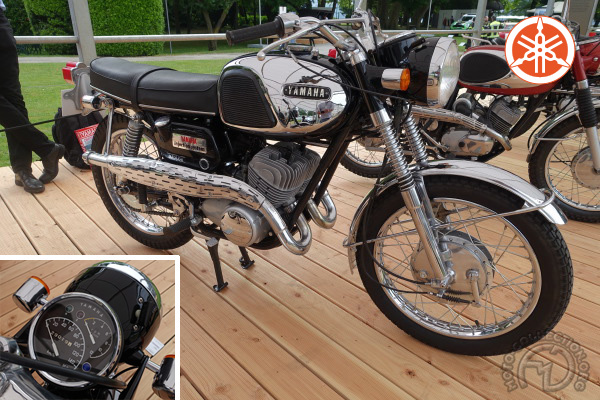
Photo ou archives : F-M. Dumas
1819
Yamaha
250 YDS 5 E & 305 YM 2 · 1967
Near-identical twins
Yamaha's world reputation was built on its two-stroke twins. The first, in 1957, was the 250 YD1, whose line ran out with the YD3 in 1963. The new F-Series YDS sports was launched in parallel in 1963, and joined in 1965 by the 305 YM "pseudo-350," shown
here in its second (and last) version, the YM2 of 1967-68, with its twin, the 250 YDS5.
Two Peas in a Pod .
In fact, only a difference of 5mm in the stroke distinguished the two versions, plus an important little accessory - the electric starter - standardized on the 250 in 1967. These two models were the last Yamaha twins with a vertical crankcase joint. They were replaced in 1968 by the 250 DS7 and a genuine 350, the YR2.
Extraordinary Competition Record
The YDS5 - and its compatriots the 1966 Suzuki T20 and the Kawasaki Samurai and Avenger- hit the European market like a bombshell and quickly took a stranglehold on the medium-capacity sports market segment. While the Yamahas were 15-20 percent more expensive than their European rivals like the 1968 Aermacchi Ala Verde and Morini Settebello, they were better finished, faster, more reliable and bathed in the aura
of an extraordinary competition record. Between its first title in 1964 and 1973, Yamaha was six times world 250cc champion, of which four (and two second places) were won by Phil React Yamaha was also champion of France in 1966, 67 and 68.
SPECIFICATIONS
Engine: 246cc (56x50mm)/301cc (60x54mm) air-cooled single-cylinder two-stroke
Power Rating: 30 hp@ 7500 rpm /31 hp@7000 rpm
Valves: two-stroke with five transfer ports
Fuel System: two 24mm Mikuni carburetors
Transmission: 5-speed; chain final drive
Suspension: telescopic forks (front); swinging fork with two spring/dampers (rear)
Brakes: twin leading shoe drum (from); drum (rear)
Wheels: 18 inch (front & rear)
Weight: 362 Jb
Maximum Speed; 100 mph
The only external difference between these two bikes was an electric starter on the 250, but they picked up the styling cues of the TD 1 C competition bike.